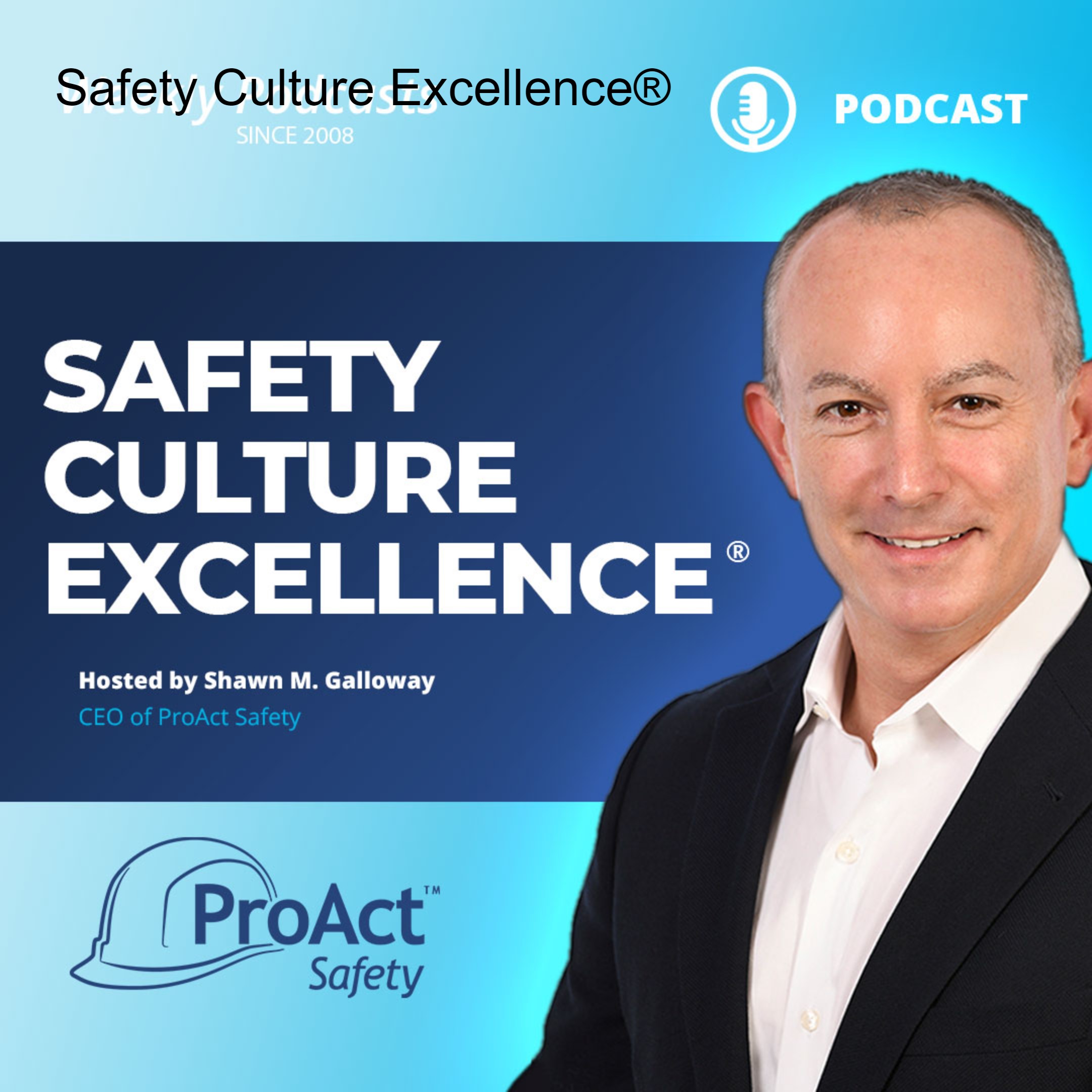Episodes
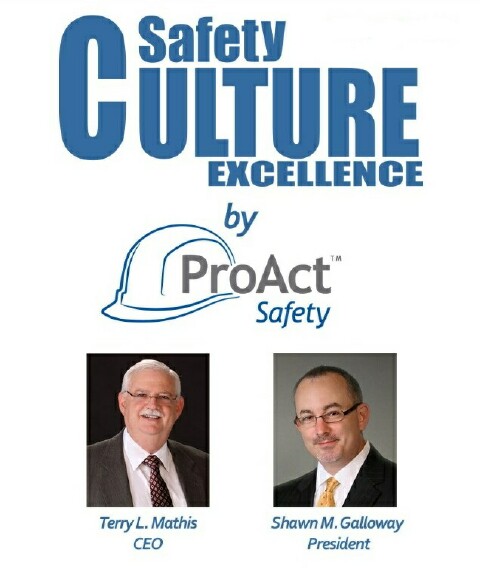
Wednesday Jul 09, 2014
Measuring Safety Culture Maturity: A Better Way
Wednesday Jul 09, 2014
Wednesday Jul 09, 2014
Forget the old ways of measuring safety culture maturity. There is a new, more effective way to measure cultural maturity and it starts with looking at the chemistry.
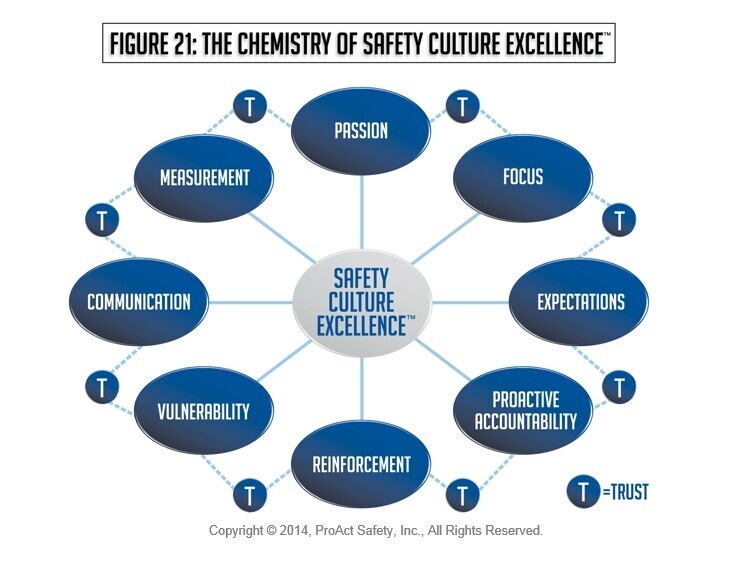
In consulting globally with many of the best in safety performance and culture, nine elements (see the picture with this post) have been identified as most important foci to establish the chemistry which facilitates the necessary climate for a culture of safety excellence to grow. Through consulting engagements and workshops, these nine elements have been successfully leveraged and measured to help organizations identify both their starting point baseline, and also to strategically prioritize which elements to focus on to advance the capabilities of their safety culture.
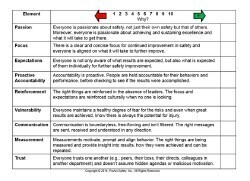
If you have read my work, participated in any of my workshops or keynote presentations or worked with me directly, you will know I work hard to always provide more take-away tools than motivational fluff. If I was able to provide the framework to facilitate the internal dialogue in article format, I would.
To assist you on your journey to safety excellence, I would like to share this tool with you. To obtain a copy for your internal use, send an email to info@proactsafety.com with the subject of Please Send Chemistry of SCE and our staff will respond at our earliest opportunity.
Cultures will always influence the beliefs and behaviors of employees and contractors as they join the group. You can either manage the chemistry, climate and culture, or the results in any area of operational performance will be managed by them. I invite you to start the conversation to strategically enhance the safety aspect of your company culture and measure your progress by contributed value, not just the lowering of injury rates.
-------------------
Shawn M. Galloway is the President and COO of ProAct Safety. He writes (and tweets:@safetyculture) about his work helping organizations in all industries to achieve and sustain excellence in their culture and performance. He resides near Houston, Texas with his wife and three children.

Wednesday Jun 11, 2014
Results and Excellence
Wednesday Jun 11, 2014
Wednesday Jun 11, 2014
A famous business leader once said there are two kinds of people in business: those who make results and those who make excuses. He called these first types of people, “results-oriented.” I would like to suggest another type. These are people who very much seek results and do not accept excuses but care deeply how those results are created. They care about the “how” for two reasons: 1. They want to create ability in their organization as well as results and 2. They want to deeply understand how results are created and how to repeat them. I call these people “excellence-oriented.”
Excellence-oriented is a step above results-oriented. It is based on longer-term thinking and the seeking of what Deming called “profound knowledge.” Excellent results can be the product of luck in the short term and excellence-oriented people understand this. That is why “zero accidents” or “zero defects” can only be goal and not a strategy for them. They understand that excellence is more than a flash in the pan or five minutes of glory. Excellence is the ability to control results over the long term and this ability is one of the most valuable commodities an organization can have in this age of global competition.
-Terry L. Mathis
For more insights, visit www.ProActSafety.com
Terry L. Mathis is the founder and CEO of ProAct Safety, an international safety and performance excellence firm. He is known for his dynamic presentations in the fields of behavioral and cultural safety, leadership, and operational performance, and is a regular speaker at ASSE, NSC, and numerous company and industry conferences. EHS Today listed Terry as a Safety Guru in ‘The 50 People Who Most Influenced EHS in 2010, 2011 and 2012-2013. He has been a frequent contributor to industry magazines for over 15 years and is the coauthor of STEPS to Safety Culture Excellence, 2013, WILEY.

Monday Jun 09, 2014
340 - STEPS to Safety Culture Excellence Workshop
Monday Jun 09, 2014
Monday Jun 09, 2014
A workshop about developing and executing against a comprehensive strategy to significantly enhance injury prevention efforts and measurably evolve the culture, by the thought-leaders at ProAct Safety
Based on the recent book, STEPS to Safety Culture Excellence, the authors will lead this workshop and provide a detailed roadmap on how to develop a three to five year safety excellence business plan. This two-day workshop is limited to ten participants. It would be helpful if each attendee read the book prior to the event to escalate the discovery process.
For more information visit: http://proactsafety.com/events/steps-to-safety-culture-excellence-workshop
Shawn M. Galloway
ProAct Safety
www.ProActSafety.com
www.SafetyCultureExcellence.com

Wednesday Jun 04, 2014
Who is Driving Safety?
Wednesday Jun 04, 2014
Wednesday Jun 04, 2014
The leaders of an organization who were asking for my help to improve their safety efforts told me that they were all pushing safety as hard as they could. I asked them who was driving safety and how long it had been stalled and needing to be pushed. Almost every leadership team is either neglecting, pushing or driving safety. Neglect brings on disaster. The need for pushing often results from previous neglect. Driving safety almost always results in progress and improvement.
Just as the term implies, driving is giving direction, speed and stability to the safety effort. Stalled efforts may require some pushing, but well-running efforts simply need drivers. The most recognized drivers of safety are leadership, supervision, guidelines, and training. Leaders need to give safety strategic direction. Supervisors need to steer and correct the daily efforts. Guidelines, such as rules, procedures, and P.P.E. requirements should provide a road map for the workplace decisions that impact safety. Training should ensure that everyone knows the guidelines and can also recognize and manage the risks in the workplace that may not be fully covered by the guidelines.
Safety efforts that are strategically driven shape the perceptions and culture of the safety efforts. The perceptions and culture combine with the training to shape the daily performance. Supervision keeps the daily performance on track. The daily performance produces the results that are measured by the lagging indicators of safety. If your lagging indicators indicate you are not at your desired destination, ask yourself “who is driving?”
-Terry L. Mathis
For more insights, visit www.ProActSafety.com
Terry L. Mathis is the founder and CEO of ProAct Safety, an international safety and performance excellence firm. He is known for his dynamic presentations in the fields of behavioral and cultural safety, leadership, and operational performance, and is a regular speaker at ASSE, NSC, and numerous company and industry conferences. EHS Today listed Terry as a Safety Guru in ‘The 50 People Who Most Influenced EHS in 2010, 2011 and 2012-2013. He has been a frequent contributor to industry magazines for over 15 years and is the coauthor of STEPS to Safety Culture Excellence, 2013, WILEY.

Wednesday Apr 23, 2014
Measuring STICK
Wednesday Apr 23, 2014
Wednesday Apr 23, 2014
The old wooden yardsticks with advertising on them were called “measuring sticks.” They were handy tools before the invention of tape measures and laser measuring devices. They had feet, inches and fractions of inches marked along the edge of the stick. You could hold them up to an item to see its length or height or stick it in liquid to see its depth.
Today, the word “stick” is used more and more to mean the retention of information. “Sticky” information is easily remembered. Remembered information is used in decision making and planning. In safety, we often attempt to communicate critical information that could potentially improve safety performance. We sometimes measure the amount or reach of this communication, but we seldom measure its “stick,” or retention. Information that is sent but forgotten does not improve safety.
So, how can we make safety information stickier and how can we measure the stick? Three easy steps to improve stickiness are to 1) start with the story, 2) stress the people and 3) tally all the numbers. For example, if you want to communicate an accident that occurred, tell the story of how it happened, stress how it impacted the people involved, and tally the number of similar accidents that could have been prevented by the same precaution that could have prevented this one. Periodically ask workers to recount recent accidents. Ask which precaution could have prevented the most accidents over the past several months or years. Measure the “stick” of your safety communication and constantly improve it.
-Terry L. Mathis
Terry L. Mathis is the founder and CEO of ProAct Safety, an international safety and performance excellence firm. He is known for his dynamic presentations in the fields of behavioral and cultural safety, leadership, and operational performance, and is a regular speaker at ASSE, NSC, and numerous company and industry conferences. EHS Today listed Terry as a Safety Guru in ‘The 50 People Who Most Influenced EHS in 2010, 2011 and 2012-2013. He has been a frequent contributor to industry magazines for over 15 years and is the coauthor of STEPS to Safety Culture Excellence, 2013, WILEY.
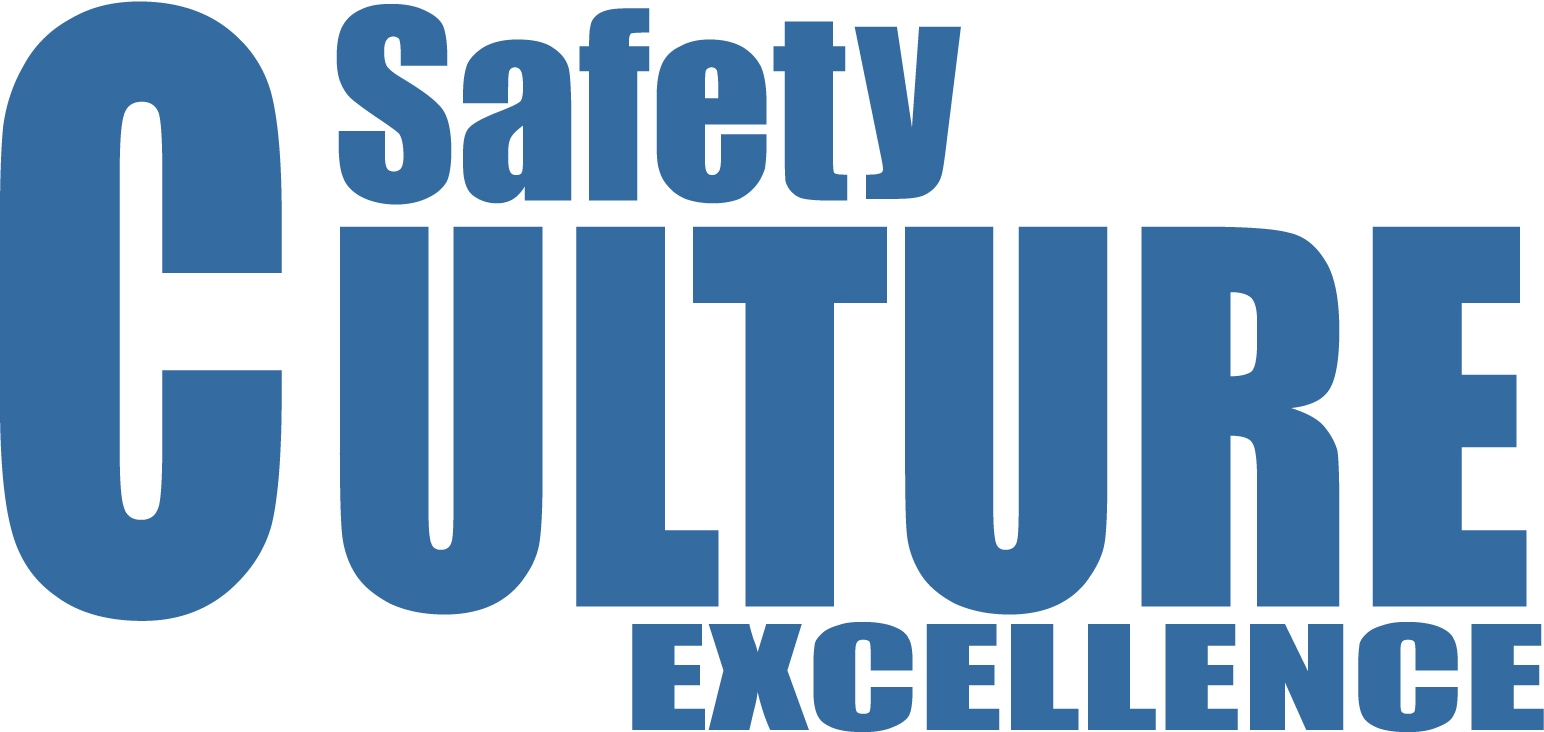
Monday Mar 03, 2014
331 - Profound Knowledge: What Drives Your Safety Strategy
Monday Mar 03, 2014
Monday Mar 03, 2014
Greetings everyone, this podcast recorded while in Gonzales, LA. I’d like to share an article I wrote that was published February 2014 in OH&S Magazine. The published article can either be found on the magazine’s website or under Insights at www.ProActSafety.com.
I hope you enjoy the podcast this week. If you would like to download or play on demand our other podcasts, please visit the ProAct Safety’s podcast website at: http://www.safetycultureexcellence.com. If you would like access to archived podcasts (older than 90 days – dating back to January 2008) please visit www.ProActSafety.com/Store. For more detailed strategies to achieve and sustain excellence in performance and culture, pick up a copy of our book, STEPS to Safety Culture Excellence - http://proactsafety.com/insights/steps-to-safety-culture-excellence
Have a great week!
Shawn M. Galloway
ProAct Safety

Monday Feb 10, 2014
328 - Five Vital Questions to Effectively Develop Leaders
Monday Feb 10, 2014
Monday Feb 10, 2014
Greetings everyone, this podcast recorded while in Grapevine, TX. I’d like to share an article I wrote that was published December 2013 in Occupational Health and Safety Magazine. The published article can either be found on the magazine’s website or under Insights at www.ProActSafety.com.
I hope you enjoy the podcast this week. If you would like to download or play on demand our other podcasts, please visit the ProAct Safety’s podcast website at: http://www.safetycultureexcellence.com. If you would like access to archived podcasts (older than 90 days – dating back to January 2008) please visit www.ProActSafety.com/Store. For more detailed strategies to achieve and sustain excellence in performance and culture, pick up a copy of our book, STEPS to Safety Culture Excellence - http://proactsafety.com/insights/steps-to-safety-culture-excellence
Have a great week!
Shawn M. Galloway
ProAct Safety

Monday Jan 20, 2014
325 - Does Poor Safety Equal Poor Management?
Monday Jan 20, 2014
Monday Jan 20, 2014
Greetings everyone, this podcast recorded while in Marble Falls, TX. I’d like to share an article Terry Mathis wrote, published November 2013 in EHS Today Magazine. The published article can either be found on the magazine’s website or under Insights at www.ProActSafety.com.
I hope you enjoy the podcast this week. If you would like to download or play on demand our other podcasts, please visit the ProAct Safety’s podcast website at: http://www.safetycultureexcellence.com. If you would like access to archived podcasts (older than 90 days – dating back to January 2008) please visit www.ProActSafety.com/Store. For more detailed strategies to achieve and sustain excellence in performance and culture, pick up a copy of our book, STEPS to Safety Culture Excellence - http://proactsafety.com/insights/steps-to-safety-culture-excellence
Have a great week!
Shawn M. Galloway
ProAct Safety

Monday Dec 23, 2013
321 - Is Failing Less a Better Safety Goal Than Achieving Success?
Monday Dec 23, 2013
Monday Dec 23, 2013
Greetings everyone, this podcast recorded while in Chicago, IL. I’d like to share an article I wrote, published October 2013 in OHS Magazine. The published article can either be found on the magazine’s website or under Insights at www.ProActSafety.com.
I hope you enjoy the podcast this week. If you would like to download or play on demand our other podcasts, please visit the ProAct Safety’s podcast website at: http://www.safetycultureexcellence.com. If you would like access to archived podcasts (older than 90 days – dating back to January 2008) please visit www.ProActSafety.com/Store. For more detailed strategies to achieve and sustain excellence in performance and culture, pick up a copy of our book, STEPS to Safety Culture Excellence - http://proactsafety.com/insights/steps-to-safety-culture-excellence
Have a great week!
Shawn M. Galloway
ProAct Safety

Wednesday Nov 27, 2013
Leading vs. Lagging Indicators in Safety
Wednesday Nov 27, 2013
Wednesday Nov 27, 2013
As more and more leaders and safety professionals realize the limitations of reactive safety, they search for leading indicators to help them manage safety more proactively. This thinking fueled the concept that lagging indicators alone, are not truly representative of safety performance, nor are they predictive or prescriptive.
The first round of so-called “leading indicators” was little more than a measurement of safety-related activities: hours of safety training, attendance at safety meetings, participation in safety programs, etc. OSHA’s crackdown on incentives that could potentially suppress reporting of accidents drove many organizations to base their incentives on these activity metrics rather than simply not having an accident.
When behavior-based safety became the rage, the measurement of behaviors from observations came to be thought of as a leading indicator. As safety culture became a buzz phrase, perception surveys gained in popularity and came to be considered another potential leading indicator. The search for meaningful leading indicators goes on because no one of these has proven adequate in predicting and preventing injuries.
Where none of these alone succeed, all of them together potentially can. A balanced-scorecard approach in which the metrics not only complement, but predict each other has proven quite effective in proactively predicting how to prevent accidents. When you measure how much activity it takes to change perceptions, how much of a change in perceptions it takes to change behaviors, and how much behavior change it takes to change the lagging indicators, you begin to truly measure the effectiveness of safety efforts. Just as balanced scorecards have revolutionized strategic management, with our most successful clients, balanced scorecards for safety have proven to have a transformational impact on safety management. How balanced are your measurements?
-Terry L. Mathis
Terry L. Mathis is the founder and CEO of ProAct Safety, an international safety and performance excellence firm. He is known for his dynamic presentations in the fields of behavioral and cultural safety, leadership, and operational performance, and is a regular speaker at ASSE, NSC, and numerous company and industry conferences. EHS Today listed Terry as a Safety Guru in ‘The 50 People Who Most Influenced EHS in 2010, 2011 and 2012-2013. He has been a frequent contributor to industry magazines for over 15 years and is the coauthor of STEPS to Safety Culture Excellence, 2013, WILEY.

